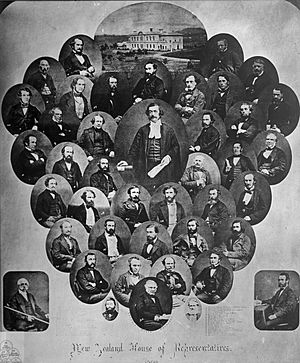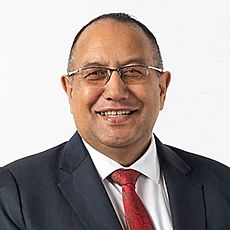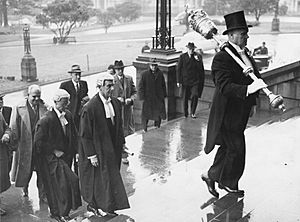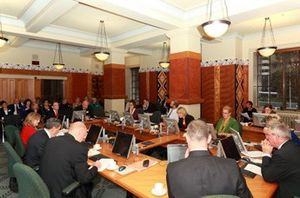New Zealand House of Representatives facts for kids
Quick facts for kids New Zealand House of Representatives |
|
|---|---|
| 53rd Parliament | |
 |
|
| Type | |
| Type |
Unicameral chamber of the New Zealand Parliament
|
| Leadership | |
|
Speaker of the House
|
Adrian Rurawhe, Labour
Since 24 August 2022 |
|
Leader of the House
|
|
|
Shadow Leader of the House
|
Michael Woodhouse, National
Since 19 January 2023 |
| Structure | |
 |
|
|
Political groups
|
Government (62)
In co-operation with (9)
Official Opposition (34)
Crossbench (14)
|
| Committees | 19 select committees |
|
Length of term
|
Up to 3 years |
| Salary | NZ$163,961 |
| Elections | |
| Mixed-member proportional representation | |
|
Last election
|
17 October 2020 |
|
Next election
|
14 October 2023 |
| Meeting place | |
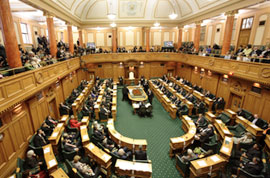 |
|
| Debating Chamber, Parliament House, Wellington | |
The House of Representatives (in Māori, Whare o Raro, meaning Lower House) is the main part of the New Zealand Parliament. It is the only chamber where laws are made. The House also chooses ministers to form the Cabinet. These ministers then manage the government's work. The House is also in charge of approving the country's budgets and checking how money is spent.
This House is a democratic group. It is made up of people called members of parliament (MPs). Usually, there are 120 MPs. However, this number can be a bit higher if there are "overhang" seats. Elections happen about every three years. They use a special system called mixed-member proportional representation. This system combines MPs elected directly from areas with MPs chosen from closed party lists.
72 MPs are elected directly from single areas called electoral districts. Other MPs are chosen from party lists. This makes sure each party gets a fair share of seats. A government is formed by the party or group of parties that has the most MPs. If no single group has a clear majority, a smaller government can be formed. This happens with special agreements to get enough support. If the government loses the support of the House, a new election might be called early.
The House of Representatives was set up in 1853. This happened because of a law from the British Parliament. At first, New Zealand had two parts to its Parliament. But the upper part, called the Legislative Council, was removed in 1950. New Zealand's Parliament gained full control over its own affairs in 1947. The main meeting room for the House is inside Parliament House. This building is in Wellington, New Zealand's capital city. Meetings are usually open for people to watch. You can also watch them on Parliament TV.
Contents
How the House Works for New Zealand
The New Zealand House of Representatives is like the British House of Commons. It follows the "Westminster system" of rules. This means it uses similar ways of working as the British Parliament. The main job of the House is to represent the people. It also passes laws for everyone in New Zealand.
The House also helps form the New Zealand Government. The government's leaders, called the Cabinet, are chosen from the MPs in the House. A government is formed when a party or group of parties has the "confidence" of the House. This means they have the support of most MPs. The prime minister leads the government. They must keep the support of the House. If the House loses trust in the government, it can vote to remove them.
Members and Elections: Who Are MPs?
The House of Representatives usually has 120 members. They are called "Members of Parliament" (MPs). In the past, they had different names. All MPs are chosen by people voting in a general election. Once they are sworn in, MPs usually serve until the next election. Elections must happen at least every three years. Sometimes, an early election can be called by the prime minister. This might happen if a government doesn't have enough support.
If an MP changes parties during their term, they might be removed from the House. MPs can also be removed for serious bad behaviour. If an MP's seat becomes empty, a special election might be held. This is called a by-election. If a list member's seat is empty, the next person on their party's list takes their place.
To be an MP, you must be a New Zealand citizen. You also need to be able to vote. MPs get a yearly salary. As of 2021, it is $163,961. Some MPs get extra pay for other jobs they do. For example, the speaker or committee leaders get more.
Current Members of the House
The 53rd New Zealand Parliament is the current group of MPs. The last general election was on 17 October 2020. The 53rd Parliament started on 25 November. It has 120 members from five different parties. 60 of these MPs are women. This is the highest number of women MPs ever.
The longest-serving MP in the House is called the "father (or mother) of the House". This is an unofficial title. Currently, Gerry Brownlee and Nanaia Mahuta share this title. They have both been MPs since 1996.
How Many Members Are There?
The House started with 37 members in 1854. The number grew to 95 by 1882. Then it was cut to 74 in 1891. Numbers slowly went up again to 99 by 1993. In 1996, the number increased to at least 120. This happened when the MMP election system started.
| Year | Number of seats |
| 1854 | 37 |
| 1860 | 41 |
| 1861 | 53 |
| 1863 | 57 |
| 1866 | 70 |
| 1868 | 74 |
| 1871 | 78 |
| 1876 | 88 |
| 1882 | 95 |
| 1891 | 74 |
| 1902 | 80 |
| 1970 | 84 |
| 1973 | 87 |
| 1976 | 92 |
| 1984 | 95 |
| 1987 | 97 |
| 1993 | 99 |
| 1996 | 120 + any overhang seats |
How Elections Work
Voting is not required in New Zealand, but many people still vote. Anyone 18 or older can vote. This includes New Zealand citizens and people living permanently in New Zealand. New Zealand was the first country to let women vote, starting in 1893.
Most elections between 1853 and 1993 used the "first-past-the-post voting" system. This means the person with the most votes wins. Since 1996, a system called mixed-member proportional (MMP) has been used. In MMP, each person gets two votes. One vote is for a local MP in their area. The other vote is for a political party.
Currently, there are 72 local MP seats. Seven of these are special seats for Māori people. The other 48 seats are given to parties based on how many party votes they got. A party needs to win one local seat or 5% of the total party votes to get these extra seats. After MMP started, no single party won a clear majority until the 2020 election. In 2020, the Labour Party won 65 out of 120 seats.
Important People and Roles
The House of Representatives chooses one of its members to be the Speaker of the House. This happens at the start of each new Parliament. The Speaker's job is to make sure the rules of the House are followed. They also manage the daily work in the meeting room. The Speaker must be fair to all sides. The House also chooses a deputy speaker and up to two assistants.
Other important roles are filled by MPs from different political parties. The prime minister leads the biggest government party. They also lead important discussions in the House. The leader of the Official Opposition leads the biggest opposition party. The leader of the House is chosen by the prime minister. Their job is to plan the government's work and laws.
Whips are like organisers for each party. They make sure their party members are in the House for important votes.
Some people who work for the House are not MPs. These include the clerk of the House and the chief parliamentary counsel. The clerk advises MPs on the rules of the House. The chief parliamentary counsel helps write new laws. These jobs are non-political.
Another important person is the serjeant-at-arms. This person keeps order and security in the House. They sit opposite the Speaker during meetings. The serjeant-at-arms also carries the mace. The mace is a special stick that shows the House has authority. It is carried into and out of the meeting room each day.
How Meetings Work
The House of Representatives usually meets from Tuesday to Thursday. They meet in a special room called the debating chamber. This room is inside Parliament House, Wellington. The layout is similar to the British House of Commons.
The seats are arranged in a horseshoe shape. The Speaker sits in a raised chair at one end. This gives them a clear view of everything. In front of the Speaker is a table. The mace rests on this table. The House cannot legally meet without the mace being there.
Clerks and other officials sit at the table. They are there to help the Speaker with rules. Government members sit on the Speaker's right. Opposition members sit on the Speaker's left. MPs are given seats based on how long they have been in their party. Ministers sit near the prime minister. The prime minister usually sits in the fourth seat in the front row on the Speaker's right. The Opposition leader sits across from the prime minister. MPs who are not ministers or spokespersons are called "backbenchers".
Discussions and Voting
MPs can speak in English, Te Reo Māori, or New Zealand Sign Language. An interpreter is provided for sign language. When speaking, MPs must address the Speaker. They say 'Mister Speaker' or 'Madam Speaker'. Other MPs should be referred to in the third person. The Speaker can "name" an MP who breaks the rules. This can lead to the MP being removed from the room.
During discussions, MPs can only speak if the Speaker calls on them. An MP can usually only speak once on the same topic. However, the MP who started the discussion can speak twice. There are time limits for speeches. These limits are usually between ten and twenty minutes. The prime minister and other party leaders can sometimes speak for longer.
When it's time to decide on something, a vote is held. First, MPs vote by voice. The Speaker asks for 'Aye' (yes) or 'No' votes. The Speaker then announces the result. If any MP disagrees, a recorded vote happens. This is called a "division". There are two ways to do this:
- Party vote: Used for most votes. The clerk calls out each party's name. A party member says how many from their party vote 'Aye' or 'No'.
- Personal vote: Used for special issues where MPs vote based on their own beliefs. MPs walk into one of two lobbies (rooms) to vote 'Aye' or 'No'. Tellers (other MPs) count the votes.
If there is a tie, the motion does not pass.
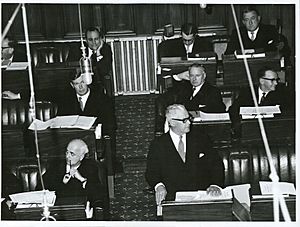
Every day, there is a time for questions to ministers. Questions must be about their official work. There are 12 questions, shared fairly among the parties. MPs can also ask questions in writing. These answers are recorded in Parliamentary Debates.
How Laws Are Made
Most of the work in Parliament is about making new laws. Proposed laws are called "bills". They go through several steps in the House. These steps are called "readings". Once a bill passes all its steps, it becomes an Act of Parliament. This means it is now part of New Zealand's law.
Bills become Acts after three votes in the House. Then, the governor-general gives it "Royal Assent". Most bills are suggested by the government. These bills help the government carry out its plans. It is rare for government bills to be rejected.
Individual MPs who are not ministers can also suggest their own bills. These are called "members' bills". They are often put forward by opposition parties. Local councils or private people can also ask an MP to introduce a bill.
First Reading: Introducing the Bill
The first step is the first reading. The MP introducing the bill explains what it is about. There is usually a two-hour discussion for government bills. MPs give ten-minute speeches on the bill's main ideas.
The MP introducing the bill usually suggests sending it to a select committee. This committee will look at the bill more closely. Sometimes, a special committee is formed for very important bills. The House then votes on whether to send the bill to a committee.
Before the first reading, the attorney-general checks if the bill follows the New Zealand Bill of Rights Act 1990. If it doesn't, they report this to the House.
Select Committee Stage: Getting Feedback
The select committee carefully checks the bill. They look at it in much more detail than the whole House can. The public can also share their thoughts with the committee. They can write comments or speak to the committee. This stage is very important today. Committees often suggest changes to bills. These changes can come from MPs, officials, or the public. Once the committee is happy with the bill, they report back to the House. Committees usually have six months to do their work.
Second Reading: Debating the Details
The second reading is another discussion, usually two hours long. MPs give ten-minute speeches. They talk about the bill's main ideas and what the select committee suggested. Parties usually decide their final view on the bill at this stage. The House then votes on any changes suggested by the select committee.
The Government can stop any part of a bill that would greatly affect its budget. This is called a "financial veto". It can be used at any stage. If a bill passes its second reading, it moves to the "committee of the whole House" stage.
Committee of the Whole House: Fine-Tuning
At this stage, all MPs form a special committee. This committee works in a slightly less formal way. They discuss the bill in detail, usually section by section. MPs can make five-minute speeches on specific parts of the bill. They can also suggest more changes.
Sometimes, MPs announce their suggested changes beforehand. These are printed on a special paper. These changes can sometimes be very big. If the government does not have a clear majority, any changes usually need to be agreed upon by other parties.
The opposition parties might also suggest changes. These changes are often to show their different ideas. Or they might just be to slow down the bill's progress.
Third Reading: Final Vote
The third reading is the last discussion. It is usually two hours long, with ten-minute speeches. MPs talk about the bill in general terms one last time. Then, a final vote is taken. If the bill passes, it goes to the governor-general. The governor-general then gives it Royal Assent, and it becomes a law.
Committees: Doing the Detailed Work
Besides the main meeting room, the House of Representatives has many committees. These committees focus on specific topics or issues. There are 12 main committees that check and change bills. They can ask for public comments. This means the public can have a say before a bill becomes law. The committee system has become stronger over time. This helps make sure laws are properly checked.
Each committee has between six and twelve members. These include a chairperson and a deputy. Parties are generally represented fairly on committees. MPs can be on more than one committee.
Sometimes, a special committee is created for a short time. For example, one was set up to study the foreshore and seabed bill.
New Zealand Youth Parliament: A Chance for Young People
Once during each Parliament term, a New Zealand Youth Parliament is held. This is a big event for young people aged 16 to 18. Individual MPs choose young people to represent them for a few days in Wellington. The Youth MPs discuss a pretend bill in the House. They also work in select committees and ask questions to ministers. The last Youth Parliament was in July 2019.
Images for kids
See also
 In Spanish: Cámara de Representantes de Nueva Zelanda para niños
In Spanish: Cámara de Representantes de Nueva Zelanda para niños


